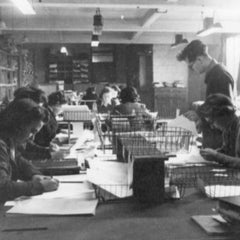
SHEroes of STEM
Women whose monumental achievements shaped the world of science, technology, engineering and math.
History is full of heroes. Some wear capes and wield weapons, defending the lives of innocent citizens, while others pick up a pen to write the words that shape a culture. But there’s nothing supernatural about the heroes highlighted here — they’re in a class of their own. They don lab coats and safety glasses to experiment with unknown substances. They use chalkboards and mathematical tables to calculate paths to undiscovered worlds. In their lifetimes, they helped shape humanity’s understanding of the world. These are the SHEroes of STEM.
It’s important to note that while some of these female trailblazers were famous in their time, many had their work stolen or claimed by someone else, and the majority fought cultural and societal opposition to their inclusion in STEM. Today, we applaud their achievements and give them the credit they deserve.
Hypatia (355-415 BC)
 Hypatia is the earliest known woman with documented contributions to STEM. The daughter of a Greek mathematician, Hypatia was an astronomer, mathematician and philosopher who wrote and taught on geometry, number theory and astronomy in Alexandria. She was a charismatic and popular lecturer who could be regularly found teaching or studying at the University of Alexandria. However, Hypatia’s city was undergoing a time of religious intolerance and social turmoil, a conflict in which her controversial views of the universe put her in danger. Hypatia was tragically murdered by a hostile mob in 415, but her work and legacy live on.
Hypatia is the earliest known woman with documented contributions to STEM. The daughter of a Greek mathematician, Hypatia was an astronomer, mathematician and philosopher who wrote and taught on geometry, number theory and astronomy in Alexandria. She was a charismatic and popular lecturer who could be regularly found teaching or studying at the University of Alexandria. However, Hypatia’s city was undergoing a time of religious intolerance and social turmoil, a conflict in which her controversial views of the universe put her in danger. Hypatia was tragically murdered by a hostile mob in 415, but her work and legacy live on.
Augusta Ada King, Countess of Lovelace (Ada Lovelace) (1815-1852)
 Ada Lovelace was one of the first to foresee today’s Age of the Computer. Her father, Lord Byron, was an influential Romantic poet and her mother, Annabella Milbanke Byron, was a mathematician. Although her parents split soon after her birth, Ada inherited strengths from each of them, embodying a combination of arts and sciences in her work. In 1833, one of Lovelace’s mentors introduced her to Charles Babbage, an inventor who was designing an “Analytical Engine,” a machine capable of complex computations. Lovelace studied his designs and had a groundbreaking realization — with the right programming, computers could deliver outputs beyond pre-programmed responses. They could make music, create art and produce writings. This idea of a multi-purpose computer never came to pass during her lifetime, but Lovelace’s writings inspired Alan Turing, the father of modern computing.
Ada Lovelace was one of the first to foresee today’s Age of the Computer. Her father, Lord Byron, was an influential Romantic poet and her mother, Annabella Milbanke Byron, was a mathematician. Although her parents split soon after her birth, Ada inherited strengths from each of them, embodying a combination of arts and sciences in her work. In 1833, one of Lovelace’s mentors introduced her to Charles Babbage, an inventor who was designing an “Analytical Engine,” a machine capable of complex computations. Lovelace studied his designs and had a groundbreaking realization — with the right programming, computers could deliver outputs beyond pre-programmed responses. They could make music, create art and produce writings. This idea of a multi-purpose computer never came to pass during her lifetime, but Lovelace’s writings inspired Alan Turing, the father of modern computing.
To learn more about Ada Lovelace, visit
https://edventures.com/blogs/stempower/happy-ada-lovelace-day
Florence Nightingale (1820-1910)
 Florence Nightingale left a comfortable life to revolutionize the worlds of nursing and statistics. As a child, Florence’s father oversaw her education, teaching languages, philosophy, history and literature along with her favorite subject — mathematics. Instead of trying to keep an easy life by marrying well and managing a home as her parents would have liked, Florence pursued nursing, training for over a decade, before becoming a superintendent at a women’s hospital. When the Crimean War began shortly thereafter, Florence was asked by the Secretary of State at War to lead a group of 38 nurses to work in a military hospital near the front lines. This was the first time women were allowed to serve in battle. Throughout her time abroad, Florence cleaned up the military hospital and increased efficiency in treating patients, trying her best to preserve lives — unfortunately, the army hospital she worked in was built on top of a sewer, meaning their water was contaminated. When she returned from the war, Florence Nightingale used her earned notoriety to campaign for better military health efforts. With the backing of Queen Victoria, she enlisted the help of some statisticians to analyze causes of soldier fatalities. They found that the vast majority of deaths were not from battle, but preventable diseases spread through unsanitary hospital conditions. In response, Florence Nightingale published two books, Notes on Nursing and Notes on Hospitals, which became the foundations for modern nursing. Florence Nightingale popularized nursing as a career for women, improved the state of hospitals everywhere and encouraged healthcare for even the poorest citizens. Her legacy lives on today in the fields of nursing and statistics.
Florence Nightingale left a comfortable life to revolutionize the worlds of nursing and statistics. As a child, Florence’s father oversaw her education, teaching languages, philosophy, history and literature along with her favorite subject — mathematics. Instead of trying to keep an easy life by marrying well and managing a home as her parents would have liked, Florence pursued nursing, training for over a decade, before becoming a superintendent at a women’s hospital. When the Crimean War began shortly thereafter, Florence was asked by the Secretary of State at War to lead a group of 38 nurses to work in a military hospital near the front lines. This was the first time women were allowed to serve in battle. Throughout her time abroad, Florence cleaned up the military hospital and increased efficiency in treating patients, trying her best to preserve lives — unfortunately, the army hospital she worked in was built on top of a sewer, meaning their water was contaminated. When she returned from the war, Florence Nightingale used her earned notoriety to campaign for better military health efforts. With the backing of Queen Victoria, she enlisted the help of some statisticians to analyze causes of soldier fatalities. They found that the vast majority of deaths were not from battle, but preventable diseases spread through unsanitary hospital conditions. In response, Florence Nightingale published two books, Notes on Nursing and Notes on Hospitals, which became the foundations for modern nursing. Florence Nightingale popularized nursing as a career for women, improved the state of hospitals everywhere and encouraged healthcare for even the poorest citizens. Her legacy lives on today in the fields of nursing and statistics.
Marie Curie (1867-1934)
 Marie Curie is the only person to ever win Nobel Prizes in two different sciences. After growing up in Poland, Marie studied physics and mathematics in Paris where she met her husband, Pierre Curie, with whom she would investigate the brand new concept of radioactivity. In 1898, the couple announced their discoveries of polonium and radium, two new chemical elements. They were awarded a Nobel Prize in Physics along with Professor Henri Becquerel for their work. In 1906, Pierre was tragically hit and killed by a carriage. Marie took over his classes at the Sorbonne, becoming the first female to ever teach there. She went on to win the Nobel Prize in Chemistry in 1911 “in recognition of her services to the advancement of chemistry by the discovery of the elements radium and polonium, by the isolation of radium and the study of the nature and compounds of this remarkable element.” Despite her success, many French male scientists opposed Marie and prevented her from profiting from her work. Her discoveries led to the use of X-rays and radiologic sciences for surgery and diagnosis. She died in 1934 from leukemia, caused by radiation exposure in her work, but her daughter went on to win a Nobel Prize for Chemistry in 1935.
Marie Curie is the only person to ever win Nobel Prizes in two different sciences. After growing up in Poland, Marie studied physics and mathematics in Paris where she met her husband, Pierre Curie, with whom she would investigate the brand new concept of radioactivity. In 1898, the couple announced their discoveries of polonium and radium, two new chemical elements. They were awarded a Nobel Prize in Physics along with Professor Henri Becquerel for their work. In 1906, Pierre was tragically hit and killed by a carriage. Marie took over his classes at the Sorbonne, becoming the first female to ever teach there. She went on to win the Nobel Prize in Chemistry in 1911 “in recognition of her services to the advancement of chemistry by the discovery of the elements radium and polonium, by the isolation of radium and the study of the nature and compounds of this remarkable element.” Despite her success, many French male scientists opposed Marie and prevented her from profiting from her work. Her discoveries led to the use of X-rays and radiologic sciences for surgery and diagnosis. She died in 1934 from leukemia, caused by radiation exposure in her work, but her daughter went on to win a Nobel Prize for Chemistry in 1935.
Lise Meitner (1878-1968)
 Lise Meitner was an Austrian physicist who worked with a team of scientists to discover and harness nuclear fission. After being one of the first two women to earn her doctorate at the University of Vienna, Lise joined Max Planck and Otto Han in Berlin to discover isotopes and investigate beta decay. During World War II, Lise fled Nazi Germany and settled in Sweden. She continued corresponding with the German scientists as Otto Hahn gathered reputable evidence for nuclear fission. Lise Meitner and her nephew, Otto Frisch, wrote the first explanation of the process and came up with the name “fission.” Hahn won a Nobel Prize in 1944 without any share given to Lise. Recognizing the explosive potential of nuclear fission, a group of scientists urged U.S. President Franklin D. Roosevelt to get ahead of the competition to develop an atomic bomb. Meitner was invited to join the Manhattan Project, but refused, stating, “I will have nothing to do with a bomb!” She continued to work and lecture until her retirement in 1960. On her tombstone reads the inscription: “A physicist who never lost her humanity.” In 1982, element 109 was discovered and named Meitnerium in Lise Meiner’s honor.
Lise Meitner was an Austrian physicist who worked with a team of scientists to discover and harness nuclear fission. After being one of the first two women to earn her doctorate at the University of Vienna, Lise joined Max Planck and Otto Han in Berlin to discover isotopes and investigate beta decay. During World War II, Lise fled Nazi Germany and settled in Sweden. She continued corresponding with the German scientists as Otto Hahn gathered reputable evidence for nuclear fission. Lise Meitner and her nephew, Otto Frisch, wrote the first explanation of the process and came up with the name “fission.” Hahn won a Nobel Prize in 1944 without any share given to Lise. Recognizing the explosive potential of nuclear fission, a group of scientists urged U.S. President Franklin D. Roosevelt to get ahead of the competition to develop an atomic bomb. Meitner was invited to join the Manhattan Project, but refused, stating, “I will have nothing to do with a bomb!” She continued to work and lecture until her retirement in 1960. On her tombstone reads the inscription: “A physicist who never lost her humanity.” In 1982, element 109 was discovered and named Meitnerium in Lise Meiner’s honor.
Amelia Earhart (1897-1937)
 Amelia Earhart defied gender stereotypes, even as a young girl. From basketball to shop class, she pursued her interests regardless of societal norms. Amelia took her first flight in 1920 and fell in love. From that point forward she trained as a pilot, working as a filing clerk to pay for flying lessons and her first plane. She earned her pilot’s license in 1921 and got started right away. Throughout her piloting career, she pushed the limits, breaking records such as the first woman to fly solo above 14,000 feet, the first woman to fly solo across the Atlantic Ocean, the first woman to fly solo across the United States and the first person to fly solo from Hawaii to the mainland United States. For her work, the United States Congress awarded her with the Distinguished Flying Cross, making her the first woman to earn that honor. Earhart worked to promote women in aviation through female air races and the Ninety-Nines, an international organization for the advancement of women pilots. In June 1937, Earhart and her navigator, Fred Noonan, took off from California to attempt a flight around the world. On July 2, Earhart and Noonan were seen for the last time in Lae, New Guinea, only 7,000 miles from completing the journey. Earhart and Noonan’s bodies were never found, creating one of the greatest mysteries of the modern 20th century.
Amelia Earhart defied gender stereotypes, even as a young girl. From basketball to shop class, she pursued her interests regardless of societal norms. Amelia took her first flight in 1920 and fell in love. From that point forward she trained as a pilot, working as a filing clerk to pay for flying lessons and her first plane. She earned her pilot’s license in 1921 and got started right away. Throughout her piloting career, she pushed the limits, breaking records such as the first woman to fly solo above 14,000 feet, the first woman to fly solo across the Atlantic Ocean, the first woman to fly solo across the United States and the first person to fly solo from Hawaii to the mainland United States. For her work, the United States Congress awarded her with the Distinguished Flying Cross, making her the first woman to earn that honor. Earhart worked to promote women in aviation through female air races and the Ninety-Nines, an international organization for the advancement of women pilots. In June 1937, Earhart and her navigator, Fred Noonan, took off from California to attempt a flight around the world. On July 2, Earhart and Noonan were seen for the last time in Lae, New Guinea, only 7,000 miles from completing the journey. Earhart and Noonan’s bodies were never found, creating one of the greatest mysteries of the modern 20th century.
Rosalind Franklin (1920-1958)
 From a young age, Rosalind Franklin knew she wanted to be a scientist. After studying chemistry at Cambridge University, Rosalind worked in a couple of different research areas before starting a 3-year project at King’s College to improve their x-ray crystallography use and investigate the structure of DNA. Due to a rocky relationship with her lab partner, Maurice Wilkins, Franklin often worked independently, eventually obtaining two high-quality photos of DNA molecules. Wilkins showed these photos to Watson and Crick, clarifying their understanding of the structure of DNA. On April 25, 1953, Nature published three articles on DNA — one by Franklin, one by Wilkins and one by Watson & Crick. Although Watson and Crick’s article was heavily based on the findings from Franklin and Wilkins, they were able to clearly and concisely describe the structure of DNA, gaining notoriety and a Nobel Prize along with that. Franklin left Cambridge to study the tobacco mosaic virus until she died of cancer in 1958. In 1999, Watson acknowledged Rosalind Franklin for her contribution, noting that her photograph of DNA was the “key event” in solidifying their understanding of DNA’s structure.
From a young age, Rosalind Franklin knew she wanted to be a scientist. After studying chemistry at Cambridge University, Rosalind worked in a couple of different research areas before starting a 3-year project at King’s College to improve their x-ray crystallography use and investigate the structure of DNA. Due to a rocky relationship with her lab partner, Maurice Wilkins, Franklin often worked independently, eventually obtaining two high-quality photos of DNA molecules. Wilkins showed these photos to Watson and Crick, clarifying their understanding of the structure of DNA. On April 25, 1953, Nature published three articles on DNA — one by Franklin, one by Wilkins and one by Watson & Crick. Although Watson and Crick’s article was heavily based on the findings from Franklin and Wilkins, they were able to clearly and concisely describe the structure of DNA, gaining notoriety and a Nobel Prize along with that. Franklin left Cambridge to study the tobacco mosaic virus until she died of cancer in 1958. In 1999, Watson acknowledged Rosalind Franklin for her contribution, noting that her photograph of DNA was the “key event” in solidifying their understanding of DNA’s structure.
Grace Hopper (1906-1996)
 Grace Murray Hopper studied mathematics and physics at Vassar University, then became an instructor there. While teaching, she earned her MA and Ph.D. in mathematics from Yale. In 1943, she left her teaching post for the United States Naval Reserve to serve during World War II. Upon completion of her training, Grace Hopper joined the Bureau of Ordnance Computation Project, working on the Harvard Mark I computer. She was the third programmer of this early computer and imagined a future in which computers could be used by everyday Americans, not just computer scientists. In order to move toward this vision, Grace Hopper developed a computer that could understand statements in English so it could be used in everyday business applications. At the same time, Hopper worked to develop a universal language to standardize compilers. This led to today’s international standards for computer programming languages. For her work, the Data Processing Management Association awarded Grace Hopper the first-ever Computer Science Man-of-the-Year title. Throughout her life, Grace Hopper transformed the use and perceptions of computers, crossing from academia to military to industry. Her impact is seen today in computers everywhere.
Grace Murray Hopper studied mathematics and physics at Vassar University, then became an instructor there. While teaching, she earned her MA and Ph.D. in mathematics from Yale. In 1943, she left her teaching post for the United States Naval Reserve to serve during World War II. Upon completion of her training, Grace Hopper joined the Bureau of Ordnance Computation Project, working on the Harvard Mark I computer. She was the third programmer of this early computer and imagined a future in which computers could be used by everyday Americans, not just computer scientists. In order to move toward this vision, Grace Hopper developed a computer that could understand statements in English so it could be used in everyday business applications. At the same time, Hopper worked to develop a universal language to standardize compilers. This led to today’s international standards for computer programming languages. For her work, the Data Processing Management Association awarded Grace Hopper the first-ever Computer Science Man-of-the-Year title. Throughout her life, Grace Hopper transformed the use and perceptions of computers, crossing from academia to military to industry. Her impact is seen today in computers everywhere.
Joan Clarke (1917-1996)
 Joan Clarke studied mathematics at Cambridge University where a supervisor named Gordon Welchman noticed her intelligence. Tasked with recruiting bright minds for a decoding operation at Bletchley Park, Welchman invited Joan Clarke, who accepted the post and began her work in June 1940. From her humble beginnings working in administrative and clerical tasks, Clarke moved up through the ranks, eventually working on cracking German Enigma codes alongside Alan Turing, Tony Kenderick and Peter Twinn. When Alan Turing developed a new method for cracking the Enigma, Joan Clarke joined as the only female on a team of 9. The team broke the code at the end of 1942 and many team members transferred to other areas of Bletchley Park. Joan Clarke stayed behind, becoming the Deputy Head and continuing to break codes until the end of the war. After the war, Clarke continued to work with codes and numbers, but much of her work remains unknown, stuck in a vault of secrets. What we do know is that she cracked codes and saved lives, making her a true hero.
Joan Clarke studied mathematics at Cambridge University where a supervisor named Gordon Welchman noticed her intelligence. Tasked with recruiting bright minds for a decoding operation at Bletchley Park, Welchman invited Joan Clarke, who accepted the post and began her work in June 1940. From her humble beginnings working in administrative and clerical tasks, Clarke moved up through the ranks, eventually working on cracking German Enigma codes alongside Alan Turing, Tony Kenderick and Peter Twinn. When Alan Turing developed a new method for cracking the Enigma, Joan Clarke joined as the only female on a team of 9. The team broke the code at the end of 1942 and many team members transferred to other areas of Bletchley Park. Joan Clarke stayed behind, becoming the Deputy Head and continuing to break codes until the end of the war. After the war, Clarke continued to work with codes and numbers, but much of her work remains unknown, stuck in a vault of secrets. What we do know is that she cracked codes and saved lives, making her a true hero.
Katherine Johnson (1918-Present)
 In 1939, West Virginia decided to integrate its graduate schools. One of the three black students chosen to attend West Virginia State College was a curious and brilliant girl named Katherine Johnson. Johnson left her teaching job to pursue a Ph.D. in mathematics but stopped partway through to start a family with her husband. In 1952, one of Katherine’s family members told her about a job opening at the all-black West Area Computing division at the National Advisory Committee for Aeronautics (NACA) Langley labs. Katherine applied for the job and got put on assignment in the Flight Research Division. For four years, Johnson studied data from crashes and flight tests, joining the Space Task Group when NACA became NASA in 1958. Johnson calculated trajectories for the first American-manned spaceflight and was personally asked by astronaut John Glenn to check the electronically calculated orbital flight path. With confidence in Johnson’s calculations, John Glenn successfully orbited around the Earth, marking a turning point in the Space Race. To this day, Katherine Johnson is an inspiration to girls in STEM.
In 1939, West Virginia decided to integrate its graduate schools. One of the three black students chosen to attend West Virginia State College was a curious and brilliant girl named Katherine Johnson. Johnson left her teaching job to pursue a Ph.D. in mathematics but stopped partway through to start a family with her husband. In 1952, one of Katherine’s family members told her about a job opening at the all-black West Area Computing division at the National Advisory Committee for Aeronautics (NACA) Langley labs. Katherine applied for the job and got put on assignment in the Flight Research Division. For four years, Johnson studied data from crashes and flight tests, joining the Space Task Group when NACA became NASA in 1958. Johnson calculated trajectories for the first American-manned spaceflight and was personally asked by astronaut John Glenn to check the electronically calculated orbital flight path. With confidence in Johnson’s calculations, John Glenn successfully orbited around the Earth, marking a turning point in the Space Race. To this day, Katherine Johnson is an inspiration to girls in STEM.
The Trimates - Jane Goodall, Dian Fossey, Birutė Galdikas (1932-1985)



The life of primates was a mystery for most of human history. In the mid-1900s, Louis Leakey, one of the leading primate anthropologists of his time, recruited three women to observe and research the behavior of three species in different geographical areas: Jane Goodall studied chimpanzees in Tanzania, Dian Fossey studied mountain gorillas in Rwanda and Birutė Galdikas studied orangutans in Borneo. Each of the three women left civilized society for a jungle-dwelling where they could observe their respective species in its natural habitat. Their work created the foundations for modern primatology and continues to support global habitat and animal conservation efforts.
Why Do We Need Women in STEM?
When women are invited to be a part of research, invention and innovation, they provide unique and valuable insights that would be missed by a male-only team. Throughout history, we have seen the tragic effects of science done without diversity. In one famous example, heart attacks were studied only in men, who exhibit different symptoms from women. Marguerite del Giudice writes, “It's now widely acknowledged that countless women with heart disease have been misdiagnosed in emergency rooms and sent home, possibly to die from heart attacks, because for decades what we know now wasn't known: that they can exhibit different symptoms from men for cardiovascular disease.” Similarly, prescription drug trials have been conducted without adequate female representation. Only after a drug makes it to a bathroom cabinet do pharmacologists see the effects they have on women.
Designing a world that serves all people requires diversity from the beginning — in the research, the testing and the implementation. To create a workforce that includes women in STEM fields, we must encourage and support girls from a young age. We do this by teaching them about female role models in the field and by giving them opportunities to pursue STEM interests and grow their abilities.
To help inspire history’s next SHEroes, check out the BrickLAB collection for hands-on STEM activities designed to engage elementary and middle school learners in every aspect of STEM.
Don't forget to check out our webinar recording:








